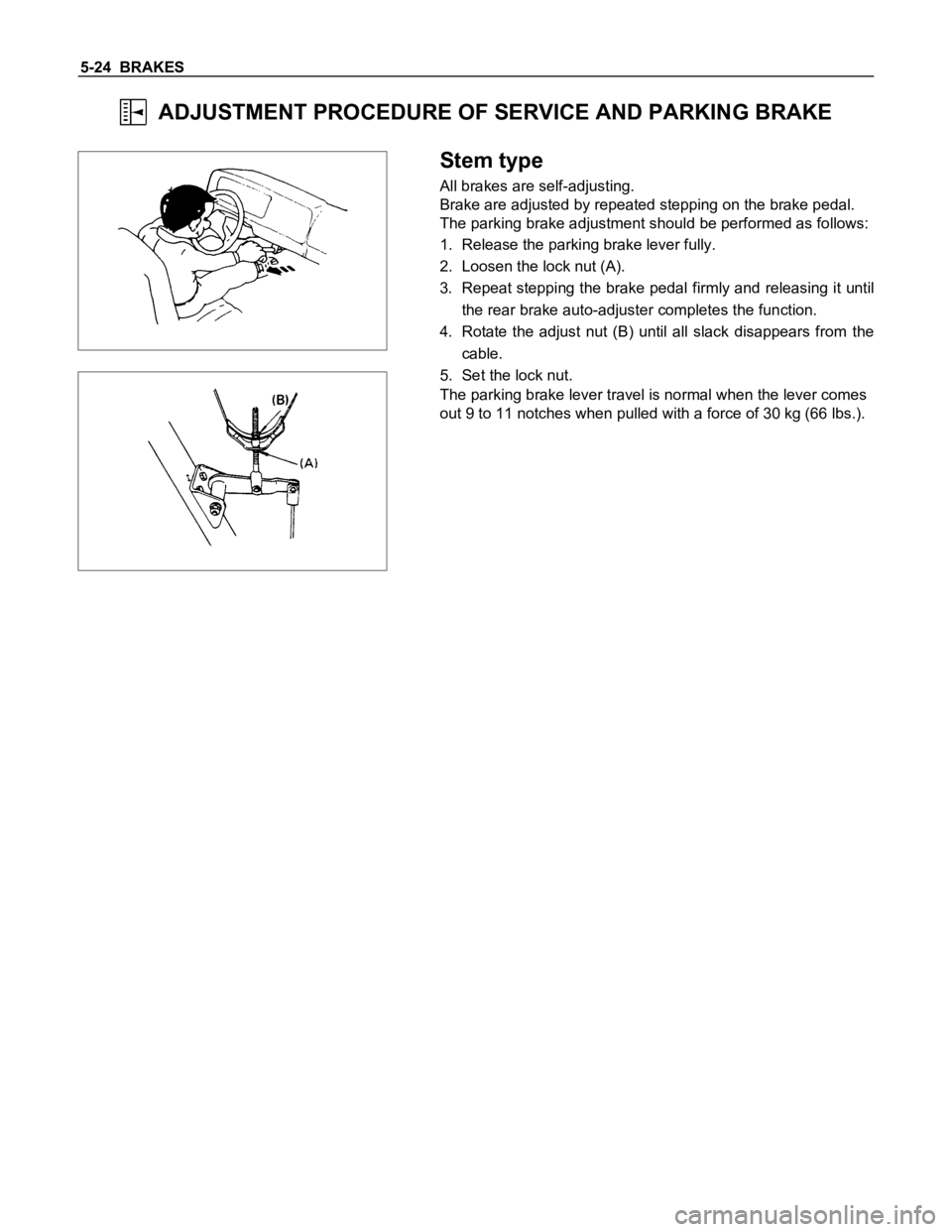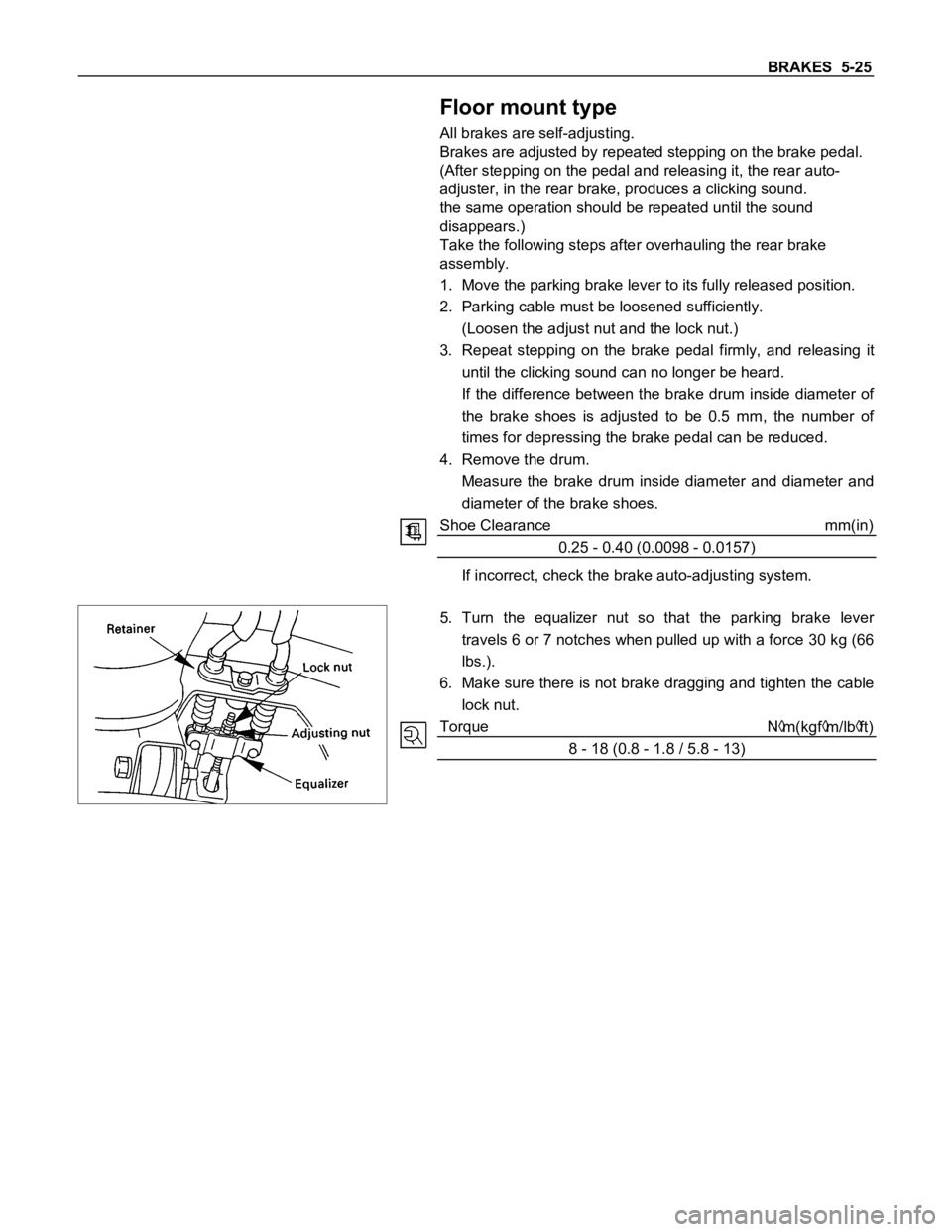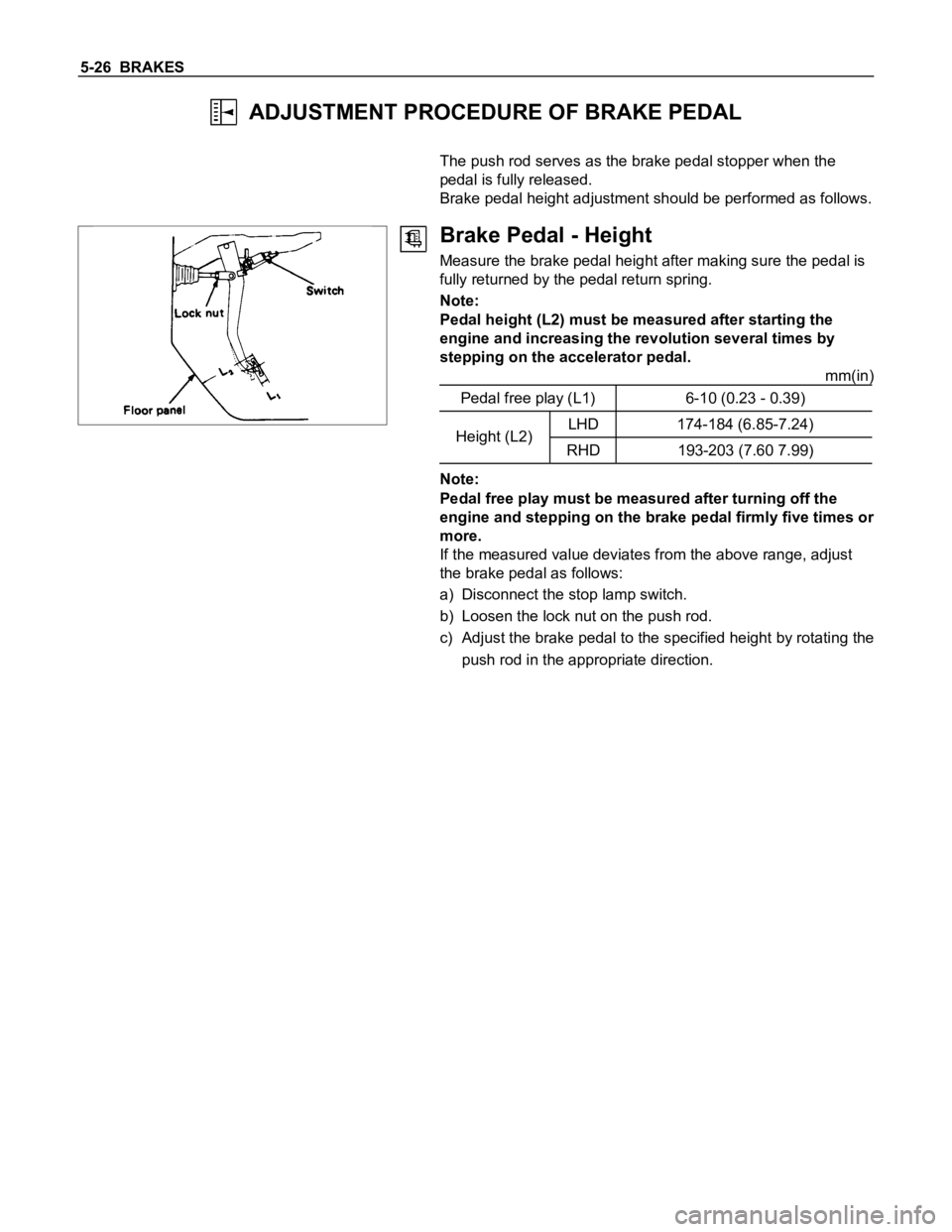brake ISUZU TFS SERIES 1997 Service Manual
[x] Cancel search | Manufacturer: ISUZU, Model Year: 1997, Model line: TFS SERIES, Model: ISUZU TFS SERIES 1997Pages: 1600, PDF Size: 40.98 MB
Page 352 of 1600

5-24 BRAKES
ADJUSTMENT PROCEDURE OF SERVICE AND PARKING BRAKE
Stem type
All brakes are self-adjusting.
Brake are adjusted by repeated stepping on the brake pedal.
The parking brake adjustment should be performed as follows:
1. Release the parking brake lever fully.
2. Loosen the lock nut (A).
3. Repeat stepping the brake pedal firmly and releasing it until
the rear brake auto-adjuster completes the function.
4. Rotate the adjust nut (B) until all slack disappears from the
cable.
5. Set the lock nut.
The parking brake lever travel is normal when the lever comes
out 9 to 11 notches when pulled with a force of 30 kg (66 lbs.).
Page 353 of 1600

BRAKES 5-25
Floor mount type
All brakes are self-adjusting.
Brakes are adjusted by repeated stepping on the brake pedal.
(After stepping on the pedal and releasing it, the rear auto-
adjuster, in the rear brake, produces a clicking sound.
the same operation should be repeated until the sound
disappears.)
Take the following steps after overhauling the rear brake
assembly.
1. Move the parking brake lever to its fully released position.
2. Parking cable must be loosened sufficiently.
(Loosen the adjust nut and the lock nut.)
3. Repeat stepping on the brake pedal firmly, and releasing it
until the clicking sound can no longer be heard.
If the difference between the brake drum inside diameter of
the brake shoes is adjusted to be 0.5 mm, the number of
times for depressing the brake pedal can be reduced.
4. Remove the drum.
Measure the brake drum inside diameter and diameter and
diameter of the brake shoes.
Shoe Clearance mm(in)
0.25 - 0.40 (0.0098 - 0.0157)
If incorrect, check the brake auto-adjusting system.
5. Turn the equalizer nut so that the parking brake lever
travels 6 or 7 notches when pulled up with a force 30 kg (66
lbs.).
6. Make sure there is not brake dragging and tighten the cable
lock nut.
Torque N
m(kgfm/lbft)
8 - 18 (0.8 - 1.8 / 5.8 - 13)
Page 354 of 1600

5-26 BRAKES
ADJUSTMENT PROCEDURE OF BRAKE PEDAL
The push rod serves as the brake pedal stopper when the
pedal is fully released.
Brake pedal height adjustment should be performed as follows.
Brake Pedal - Height
Measure the brake pedal height after making sure the pedal is
fully returned by the pedal return spring.
Note:
Pedal height (L2) must be measured after starting the
engine and increasing the revolution several times by
stepping on the accelerator pedal.
mm(in)
Pedal free play (L1) 6-10 (0.23 - 0.39)
LHD 174-184 (6.85-7.24)
RHD 193-203 (7.60 7.99)Height (L2)
Note:
Pedal free play must be measured after turning off the
engine and stepping on the brake pedal firmly five times or
more.
If the measured value deviates from the above range, adjust
the brake pedal as follows:
a) Disconnect the stop lamp switch.
b) Loosen the lock nut on the push rod.
c) Adjust the brake pedal to the specified height by rotating the
push rod in the appropriate direction.
Page 355 of 1600

BRAKES 5-27
Lock Nut Torque Nm(kgfm/lbft)
15- 25 (1.5 - 2.5 / 11 - 18)
d) Install the stop lamp switch.
Note:
Pedal height (L
2) must be 95 mm (3.7 in.) or more when
applying about 50 kg (110.25 lbs.) of stepping force.
Clearance
Between the Switch Housing and the Brake Pedal (A).
mm(in)
0.5 - 1.0 (0.02 - 0.04)
Page 356 of 1600

5-28 BRAKES
FRONT BRAKE ASSEMBLY
REMOVAL AND INSTALLATION
Removal Steps
1. Brake flexible hose
2. Lock bolt
3. Pad assembly with shim
4. Clip ; pad
5. Caliper assembly
6. Support bracket
7. Front hub and disc assembly
Installation Steps
7. Front hub and disc assembly
6. Support bracket
5. Caliper assembly
4. Clip ; pad
3. Pad assembly with shim
2. Lock bolt
1. Brake flexible hose
Important Operations - Removal
1. Brake Flexible hose
Remove the bolt and gasket and disconnect the brake flexible
hose from the caliper.
After disconnecting the flexible hose, cap or tape the openings
to prevent entry of foreign material.
Page 357 of 1600

BRAKES 5-29
2. Lock Bolt
Remove the lock bolt from the caliper.
3. Pad Assembly with Shim
Rotate the caliper upward.
Mark the lining locations if they are to be reinstalled.
6. Support Bracket
Take care not to damage the flexible brake hose when
removing the support bracket.
7. Front Hub and Disc Assembly
For the removal procedure, refer to Section 4C "FRONT
WHEEL DRIVE".
Page 358 of 1600

5-30 BRAKES
Important Operations - Installation
7. Front Hub and Disc Assembly
For the installation procedure, refer to the front hub and disc
reassembly procedure in Section 4C "FRONT WHEEL DRIVE".
6. Support Bracket
Torque N
m(kgfm/lbft)
139 - 171 (14.2 - 17.4 / 103 - 126)
Set up the clip and pad before installation of the support racket.
4. Clip ; Pad
Install new parts if necessary.
2. Lock Bolt
Torque N
m(kgfm/lbft)
27 - 37 (2.8 - 3.8 / 20 - 27)
1. Brake Flexible Hose
Attach the bolt and new gasket
Torque N
m(kgfm/lbft)
29 -39 (3.0 - 4.0 / 22 - 29)
After installation, bleeding and replenishing procedure must be
performed.
Wipe the circumference of the hose clean.
Note:
Always use new gaskets.
Be sure to put the hooked edge of the flexible hose end
into the anti-rotation cavity.
Page 359 of 1600

BRAKES 5-31
REMOVAL AND INSTALLATION OF DISC PAD
Removal Steps
1. Lock Bolt
Remove the lock bolt from the caliper.
Note:
Don't remove the brake hose from caliper when replacing
pads.
2. Rotate the Caliper Upward
Remove the caliper from the support bracket and ire the caliper
to the upper link or the frame.
Note:
While caliper is removed from support bracket, never step
on the brake pedal or the piston will protrude rapidly.
3. Pad Assembly with Shim
Remove the pad assembly with the shim.
Mark the pad locations if they are to be reinstalled.
4. Clip ; Pad
Discard the used clip and install a new one.
Page 360 of 1600

5-32 BRAKES
Installation Steps
1. Clip ; Pad
2. Pad Assembly with Shim
After attaching the pad assembly with the shim to the support
bracket, position the wear indicator to the lower side of the pad.
3. Caliper Assembly
Lower the caliper into its original position.
Do not damage the flexible hose by twisting or pulling it.
4. Lock Bolt
Attach the lock bolt to the caliper.
Torque N
m(kgfm/lbft)
27 - 37 (2.8 - 3.8 / 20 - 27)
Page 361 of 1600

BRAKES 5-33
DISASSEMBLY
CALIPER ASSEMBLY
Disassembly Steps
1. Sleeve
2. Dust boot ; sleeve
3. Dust boot ; guide pin
4. Bleeder with cap
5. Dust seal ring6. Dust seal ; piston
7. Piston (with seal ring)
8. Ring seal
9. Body ; caliper